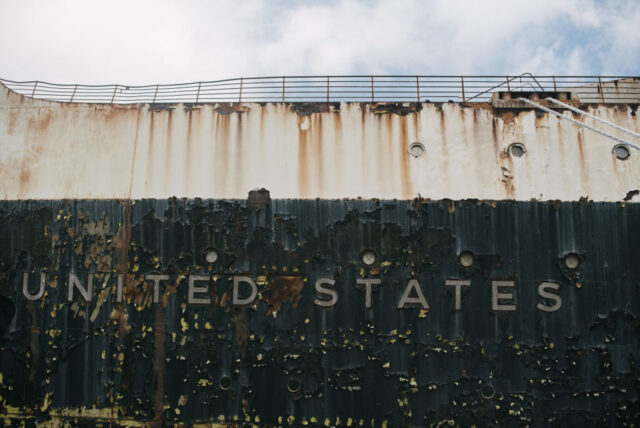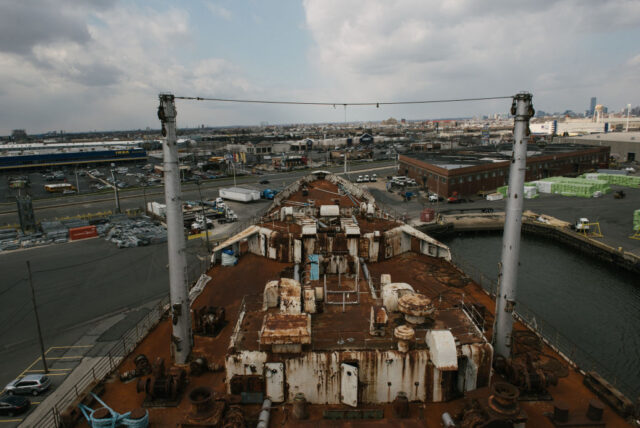When you think of ships named after the United States, the USS America (CV-66) likely comes to mind, but what if we told you there was a passenger ship with a similar name? The SS United States, launched in the early post-war era, was once considered the height of of luxury. Today, she’s just a shadow of her former self.
Desire to be a leader in maritime engineering

Following the Second World War, the United States sought to establish itself as a leader in both maritime engineering and travel. In an era where the country was navigating the still turbulent waters of the emerging nuclear age and controversy surrounding what become known as the Revolt of the Admirals, major decisions had to be made about the military’s future, with specific focus on the USS United States (CVA-58) supercarrier.
See you, USS United States (CVA-58). Hello, SS United States!

To cut a long story short, the decision was made to cancel construction of the USS United States. Only the keel had been laid down, meaning the dry dock could be freed up for other projects – specifically, the ocean liner SS United States, which would serve as a symbol of American ingenuity.
An ocean liner that can serve as a military vessel

Spearheaded by naval architect William Francis Gibbs, the SS United States was designed to be the fastest and most advanced ocean liner to ever transit the high seas. There was also the possibility that the vessel could be requisitioned by the military for service as a transport or hospital ship (the Korean War had just begun), meaning military-grade specifications were taken into account.
Working closely with the US Navy

To ensure it could perform its purpose as a dual civilian-military vessel, those working on the SS United States worked closely with members the US Navy. This was notably seen in the development of the ocean liner’s propulsion system, made up of four Westinghouse double-reduction geared steam turbines.
This allowed for the vessel to reach speeds of up to 38.32 knots, making United States the fastest ocean liner of her time.
Learning from prior incidents

Prior incidents were also taken into account during the construction of the SS United States – specifically, the devastating fires suffered aboard the SS Normandie and Morro Castle. William Francis Gibbs tried to avoid the use of wood when building the ocean liner, with parts needing to be made from the material undergoing stringent testing to ensure their safety.
Luxury was the name of the game for the SS United States

While there was the possibility that the SS United States could be called to serve in conflict, the vessel was an ocean liner, which meant there was a focus on making it as comfortable and appealing to guests as possible. Her interior was impressive, offering a mix of luxury and comfort, and the use of glass, metal and fibreglass created a modern aesthetic.
What amenities were available to guests?

With three classes – first class, cabin class and tourist class – accommodated, the SS United States needed not just lodging space, but a host of enticing amenities. There were multiple dining areas and lounges, and a theater, observation lounge, ballroom and children’s playroom were also onboard. For those able to afford first class, private rooms were available with ensuite bathrooms.
How much did the SS United States cost to build?!

The SS United States cost a whopping $79.4 million to construct, with the federal government providing nearly 70 percent of that total. Work occurred between 1950-52 at Newport News Shipbuilding and Drydock Company in Newport News, Virginia, at which point the ocean liner was launched.
Setting speed records on the Atlantic Ocean

The SS United States embarked on her maiden voyage in July 1952, and it wasn’t long before she was setting transatlantic speed records. One such journey, from New York to the United Kingdom, earned her the coveted Blue Riband, with the trip spanning just over 10 days – quite fast for the time.
Star-studded guests aboard the SS United States

The prestige surrounding the SS United States made her a favorite among the world’s elite. Several big-name Hollywood stars, such as Marilyn Monroe, Cary Grant, Walt Disney and Judy Garland, transited the Atlantic aboard her, as did Spanish artist Salvador Dalí.
Disney enjoyed his time aboard the ocean liner so much that he even used her as the backdrop for his 1962 film, Bon Voyage!, starring Tommy Kirk, Fred MacMurray and Jane Wyman.
Airplanes become the superior mode of travel

Sadly, all good things must come to an end, and this was the case with the SS United States. As airline travel became more stable an option, travelers began taking to the skies, instead of the seas – and it’s not surprising as to why. Air travel was incredibly fast, compared to days spent at sea.
The decline in passengers, paired with the costs of operating and maintaining an aging ocean liner, led to United States being withdrawn from service in 1969.
No longer of use to the US government

Following her retirement, the SS United States remained laid-up for decades, with the US Maritime Administration deeming in 1978 that the ocean liner was no longer of use to the federal government, allowing for her to be sold.
This was the beginning of the vessel changing hands on multiple occasions.
From ocean liner to condominium? Not so fast…

Seattle developer Richard Hadley purchased the SS United States in the 1980s, with the intention of turning her into a floating condominium. However, the finances weren’t there and she was left to fend for herself in the elements.
Leaving the SS United States exposed to the elements

By the next decade, signs of neglect were beginning to show, such as flaking paint and a rusting hull. With the threat of scrapping looming over her, efforts were made to try and repurpose the SS United States, but none ever came to fruition, either because of financial constraints or logistical challenges.
SS United States Conservancy

The vessel’s uncertain future received a glimmer a hope in 2010, when the SS United States Conservancy, a nonprofit dedicated to preserving and restoring the ship, stepped in and purchased the ocean liner. She was then moored along the East Coast, at Pier 82 in Philadelphia, Pennsylvania, where fundraising efforts began to bring her back to her former glory.
Partnering with RXR Realty

As part of its efforts to keep the ocean liner afloat, the SS United States Conservancy has approached various organizations to develop potential revitalization plans. Among them was RXR Realty, who proposed turning the vessel into a public attraction, complete with a park, a 1,000-room hotel, a dining location, an events venue and a museum.
These plans were still being developed when United States was evicted from Pier 82.
Evicted from Pier 82

In recent years, the owner of Pier 82, Penn Warehouses, has hiked up the rent required to keep the SS United States at the site. A subsequent disagreement led the company and the SS United States Conservancy to sue each other, with a judge issuing a ruling in June 2024, which stated the ocean liner needed to be removed by September 12.
What does the SS United States‘ future entail?

In the direct aftermath of the ruling, the SS United States Conservancy launched a fundraiser for the ocean liner’s move to a new location. It also requested that the deadline be pushed back to December 2024, to ensure there’s enough time for the relocation.
An artificial reef?

In October 2024, it was announced that a contract had been signed to turn the SS United States into an artificial reef in the Gulf of Mexico. If this comes to fruition, the former ocean liner would become the largest such reef in the world.
More from us: Before and After: 10+ Historic Buildings That Were Lost to the Wrecking Ball
Want to become a trivia master? Sign up for our Today In History newsletter!
The contract was approved by officials in Florida’s Okaloosa County, with the aim being to not only support local marine life, but bring in millions of dollars a year by turning the ship into a recreational diving site. Once the transaction has occurred, it’s slated to take about a year and a half to clean and sink United States beneath the water’s surface.
